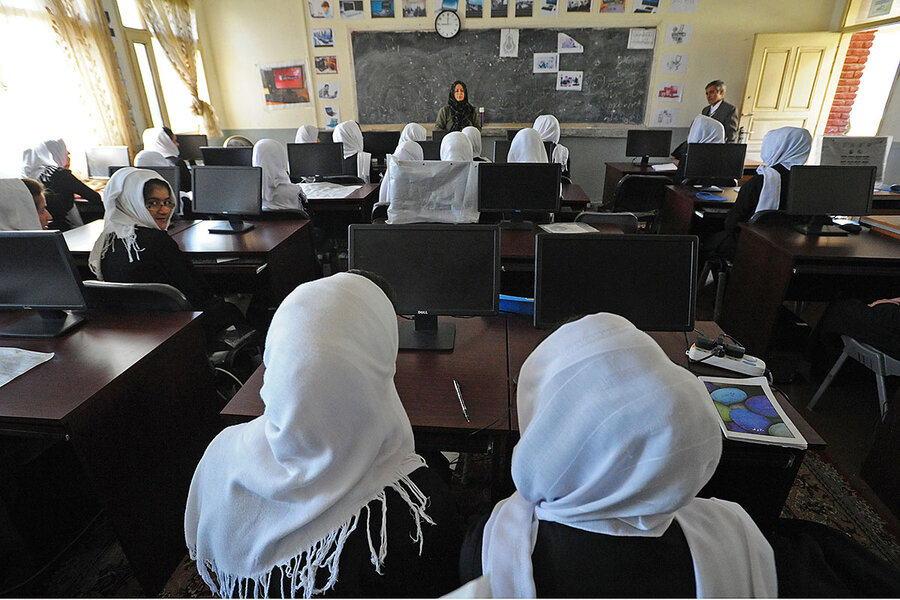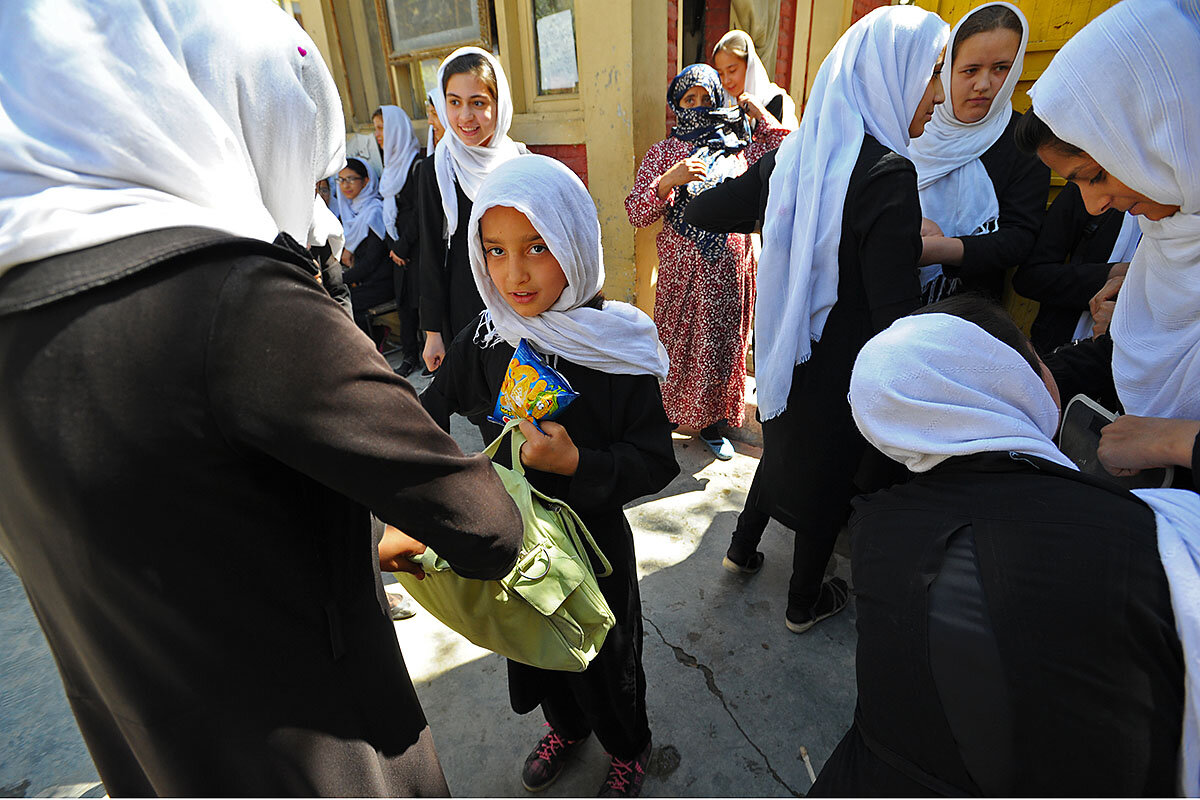Afghan girls' education: islands of progress in a sea of adversity
Loading...
| Kabul, Afghanistan
As the girls pile through the metal front door of the Sufi Mohamed Islam Secondary School in Kabul, older fellow students standing in a row give them a pat-down search and check backpacks.
The daily ritual is a nod to chronic insecurity in Afghanistan, and to the continued challenge of educating girls in a deeply conservative society.
Unlike female students in some Afghan provinces, girls in the capital don’t have to cope with harassment, acid attacks, or poisoning of food and water supplies.
“Fortunately, we are not faced with these problems,” says Safa, a 17-year-old student who dreams of owning a computer or mobile phone business. “Unfortunately, we are faced with security problems like explosions and suicide bombs. This is a fact of life.”
Sixteen years after US-backed forces toppled the arch-conservative Taliban and overturned their ban on girls’ education, students here cram into classrooms to study calculus, conduct chemistry and physics experiments, and hone their English and computer skills.
Girls’ education is frequently put forward as a success by donors. And these young women are models of what can be achieved: Among this crop of future teachers, doctors, and businesswomen, aspirations could not be higher.
“I have this power and I believe in myself.… It’s my goal to serve my country, it’s my target,” says Safa, echoing other high-achievers within these walls, where 4,000 students attend class in three shifts each day.
But in many ways the shining example of Kabul is a rare urban island for girls’ education.
As the Taliban insurgency has steadily gained ground in recent years – seizing control of more than one-third of Afghanistan so far, by the most conservative estimates – concerns are mounting that education trends for girls have begun to reverse.
While the demand for basic education for girls has risen even in rural areas, and individual families are making serious sacrifices to educate their daughters, the situation for girls is more typically grim beyond urban centers, educators and students here say.
Zubeidah’s family came from Wardak Province years ago, for example, where the Taliban closed the girls’ school in 2010. The girls who have been forced to study at home “are brave,” says the 17-year-old, who loves her math and English classes and aims to be a doctor “to serve my country, and my people.”
Her girlfriends in Wardak “are hopeless for their lives,” says Zubeidah. “They can’t learn. They want to be doctors and teachers, and can’t do it.”
Two-thirds still not in school
No one disputes the huge progress made by girls and women since the days of Taliban rule in the late 1990s, when education for girls was forbidden – except for the study of the Quran – and there were strict limitations on women working. In one memorable Taliban ruling, the windows of houses were ordered blacked out so that women could not be seen from the outside.
But even today, some two-thirds of Afghan girls don’t go to school, according to statistics compiled in a mid-October report by Human Rights Watch (HRW), which charts the decline of girls’ education.
Robust Afghan government and Western donor efforts have “significantly faltered” in recent years, HRW found, as Western forces began to draw down, and donors packed their bags or shrunk their aid.
Based on nearly 250 interviews, the report found that “insecurity, poverty, and displacement are now driving many girls out of school,” said Liesl Gerntholtz, the women’s rights director at HRW, in a statement.
“The government needs a renewed focus to ensure all girls have a school to attend or risk these gains being lost,” said Ms. Gerntholtz. Government figures indicate that of 3.5 million Afghan children not enrolled in school, 85 percent are girls. Adolescent boys are nearly twice as likely to be literate – still just 66 percent – compared with Afghan girls.
Shift in Taliban policy
Despite indications that progress has stalled in girls’ education, critical changes have taken place during the decade and a half since Taliban rule – even among the Taliban, whose official policy now condones a degree of education for girls.
“I think the needle has moved,” says a Western official in Kabul, who could not be named because he is not authorized to speak to the media.
Research indicates that “ordinary villagers are demanding at least basic education for their girls,” says the official. That alone is a turnaround from a decade ago, when the Ministry of Education set up a roving commission to prevent parents – let alone the Taliban – from burning down schools.
“Until what age they allow girls’ education is definitely unclear, and will vary according to the mores of the area, and the mores of whoever commands that area, whether it is a local militia or a Taliban commander,” says the official.
The more inclusive Taliban education policy penned in 2012 was approved by Hibatullah Akhundzada, who is today the Taliban leader and “has been a great promoter of consistent doctrine within the Taliban,” says the Western official. Mr. Akhundzada rose to fame in the 1990s, going from being a judge in a small court in Kandahar to doing internal discipline of Taliban forces as head of military courts in Kabul.
Akhundzada’s “efforts to regularize the policy have not really been successful,” adds the official. “We keep seeing places where it’s just impossible for a girl to go to school at all, because some local Taliban commander says no, despite the policy.”
But the official Taliban adjustment is nevertheless part of a broader progression in Afghanistan, says Abdul Qahar Jawad, spokesman for the Ministry of Higher Education in Kabul.
“Their strictness in 1996 was because they came off the mujahideen era, when the country was under war, and there was so much [lawlessness] ... and conservativeness was at a high peak,” says Mr. Jawad.
Taliban exposed to pressures
The Taliban’s hard-line rules were a bid to control the situation and exercise power, he says, but the militants have also experienced 16 years of increased social freedom, education, and a freer press.
“These tendencies might have affected the Taliban, too,” says Jawad. “Most of the younger generation are attracted to a new model for their lives, and that is not as strict a model as their fathers’ or grandfathers’.”
Indeed, the transformation could not be more dramatic, say educators at this Kabul secondary school whose careers spanned the Taliban era of the 1990s.
“It was a big difference, like between the ground and the sky,” says Ghulam Nabi, a 40-year-veteran math teacher with a slight build, who recalls how the Taliban devoted half of the curriculum – for boys only – to Islamic studies. Today he works on differential equations with his top girl students.
Things have improved significantly since 2001, he says, “but we are still dealing with problems.”
Those include fear of losing the gains of the past 16 years, even if a complete return to strict Taliban ideology is out of the question.
Families sacrifice
“Now people are educated, they won’t turn back to the past,” says Mina Durzad, the director of the school, who in the 1990s quietly ran a school for more than 2,000 girls. When Taliban enforcers arrived, she told them the girls were only learning the Quran – one copy of the Quran per student was kept in the makeshift classrooms – or she said she was not allowed to speak to any men, and they would have to return to speak to her husband.
The Taliban “will never return back because people don’t want them back,” says Mrs. Durzad. “I am not satisfied with [what I see in] the future, but if all people work together, work for their country, then education will become a base for progress…. If we were educated in the past, we would not face this problem.”
Parents have recognized the need for education, too, even if living in areas where prospects are limited, by militants or by custom.
“Many families are also fighting desperately to educate their daughters in the face of enormous obstacles and deserve support,” states HRW.
It found families who “moved across cities and even across the country to find a school for their daughters, who separated to allow girls to study, and who had older brothers make the dangerous trip to work illegally in Iran to pay school costs for their younger sisters back home.”
Such efforts have paid off for Safa and her younger sister Sana, who like all the students here wears the uniform white headscarf at school. Their mother stopped being a doctor and switched careers, in order to teach at their girls’ school.
“The important point is Afghanistan is back and dealing with many problems, because so many women are illiterate,” says Sana, 16, who hopes to be a computer scientist. “If you want to build your country, you should have educated women.”









